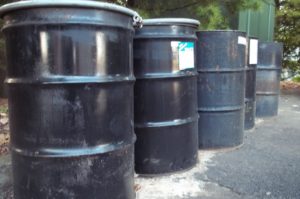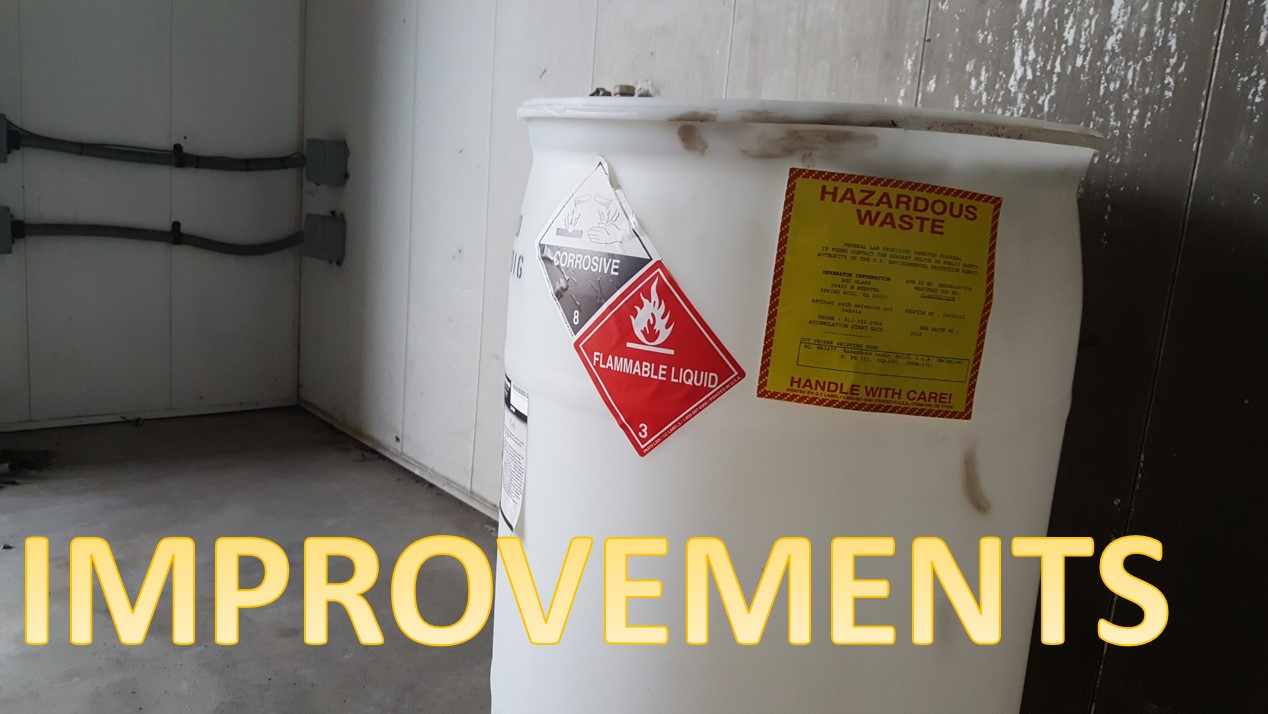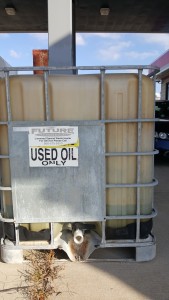Generators of hazardous waste are required to conduct a hazardous waste determination and to count the hazardous waste generated in order to determine their hazardous waste generator category. If a generator mixes its hazardous waste with a solid waste (i.e., a non-hazardous waste), the resulting mixture may have an effect on both of the just-mentioned regulatory requirements and a lot more. For that reason, USEPA thought it wise to include revised regulations on the mixing of hazardous and non-hazardous waste in the Generator Improvements Rule.
The purpose of this article is to identify and explain the regulatory responsibilities at 40 CFR 262.13(f) for a hazardous waste generator if it mixes its hazardous waste with non-hazardous waste.
Before we begin…
The regulations of §262.13(f) are partially affected by the reorganization of the generator regulations undertaken by the Generator Improvements Rule (read: Reorganization of the Generator Regulations). The mixing provisions for VSQGs now found in §262.13 were previously located in §261.5(i) and (h).
There are two types of hazardous waste:
- Hazardous waste (aka: non-acute hazardous waste)
- Acute hazardous waste
Hazardous waste is identified at §261.3. To briefly summarize, it is a solid waste, not excluded by regulation, that either displays a characteristic of a hazardous waste or is a listed hazardous waste. Identifying a hazardous waste is the purpose of the Hazardous Waste Determination.
An acute hazardous waste is defined at §260.10:
Acute hazardous waste means hazardous wastes that meet the listing criteria in §261.11(a)(2) and therefore are either listed in §261.31 of this chapter with the assigned hazard code of (H) or are listed in §261.33(e) of this chapter.
Read: FAQ: How does the Generator Improvements Rule define an acute hazardous waste?
Contact me with any questions you may have about the transportation of hazardous materials by air, highway, vessel, or rail International and Domestic Daniels Training Services, Inc. 815.821.1550 |
Generator categories are now (thanks to the Generator Improvements Rule) defined at §262.10 as follows:
Large quantity generator (LQG) is a generator who generates any of the following amounts in a calendar month:
(1) Greater than or equal to 1,000 kilograms (2200 lbs) of non-acute hazardous waste; or
(2) Greater than 1 kilogram (2.2 lbs) of acute hazardous waste listed in §261.31 or §261.33(e) of this chapter; or
(3) Greater than 100 kilograms (220 lbs) of any residue or contaminated soil, water, or other debris resulting from the cleanup of a spill, into or on any land or water, of any acute hazardous waste listed in §261.31 or §261.33(e) of this chapter.
Small quantity generator (SQG) is a generator who generates the following amounts in a calendar month:
(1) Greater than 100 kilograms (220 lbs) but less than 1,000 kilograms (2200 lbs) of non-acute hazardous waste; and
(2) Less than or equal to 1 kilogram (2.2 lbs) of acute hazardous waste listed in §261.31 or §261.33(e) of this chapter; and
(3) Less than or equal to 100 kilograms (220 lbs) of any residue or contaminated soil, water, or other debris resulting from the cleanup of a spill, into or on any land or water, of any acute hazardous waste listed in §261.31 or §261.33(e) of this chapter.
And…
Very small quantity generator (VSQG) is a generator who generates less than or equal to the following amounts in a calendar month:
(1) 100 kilograms (220 lbs) of non-acute hazardous waste; and
(2) 1 kilogram (2.2 lbs) of acute hazardous waste listed in §261.31 or §261.33(e) of this chapter; and
(3) 100 kilograms (220 lbs) of any residue or contaminated soil, water, or other debris resulting from the cleanup of a spill, into or on any land or water, of any acute hazardous waste listed in §261.31 or §261.33(e) of this chapter.
Though §262.13(f) refers to mixing a hazardous waste with a solid waste, in the Federal Register publication of the Final Rule USEPA makes it clear that it is referring to the mixing of a hazardous waste with a non-hazardous waste (81 FR 85756).
This article refers to the Federal regulations of the USEPA as revised by the Generator Improvements Rule on May 30, 2017. As of this writing, your state may not have adopted the Generator Improvements Rule. When your state does adopt the Generator Improvements Rule (all of it or at least the more stringent requirements by July 1, 2019) it may not adopt all of the regulations of §262.13(f) as identified in this article. Be sure to check with your state!
Introduction:
Initially, USEPA proposed for these regulations to be included with the conditions for exemption from permitting for each respective hazardous waste generator category:
- §262.14(b) for very small quantity generator (VSQG)
- §262.16(d) for small quantity generator (SQG)
- §262.17(f) for large quantity generator (LQG)
However, based on comments received, the Final Rule placed these regulations for all generator category in §262.13(f) since, as USEPA stated:
The act of mixing a solid waste and a hazardous waste is not the same as a generator accumulating hazardous waste, nor is the act of mixing in any way related to the conditions for exemption from permitting.
USEPA’s purpose is to make generators aware of the regulations applicable to mixtures of hazardous waste and solid waste, and to accurately explain how the mixing of a hazardous waste with a non-hazardous waste may affect a generator’s category determination for the calendar month.
Like this article? Subscribe to my Monthly Newsletter No marketing emails! |
Scope and Application:
- These regulations apply solely to a hazardous waste generator and not to a Treatment, Storage and Disposal Facility (TSDF) or transporter of hazardous waste.
- Though their responsibilities under the regulations differ, any category of a hazardous waste generator – very small quantity generator (VSQG), small quantity generator (SQG), or large quantity generator (LQG) – may mix their hazardous waste with a non-hazardous waste.
- A generator may only mix the hazardous waste and non-hazardous waste it generated on-site and not the waste of others generated at another location.
- The mixing of an acute hazardous waste with a non-hazardous waste subject to the conditions of this regulation is not forbidden.
- A generator may mix both listed and characteristic hazardous waste with non-hazardous waste subject to the conditions of this regulation.
Mixing Hazardous Waste with a Non-Hazardous Waste at a Very Small Quantity Generator [§262.13(f)(1)(i) & (ii)]:
If a VSQG mixes its hazardous wastes with non-hazardous waste and the resulting mixture does not exhibit the characteristic of a hazardous waste (e.g, Ignitable, Corrosive, Reactive, or Toxic), then:
- The VSQG may manage the mixture subject to the regulations of a VSQG even if the quantity of the mixture exceeds the monthly quantity limits of a VSQG as defined at §260.10:
- 100 kg (220 lb) per month non-acute hazardous waste.
- 1 kg (2.2 lb) per month acute hazardous waste.
- 100 kg (220 lbs) per month residue from cleanup of acute hazardous waste.
- The mixture is also not subject to the VSQG accumulation quantity limits of §262.14(a)(3) or (4):
- 1,000 kg (2,200 lb) of non-acute hazardous waste.
- 1 kg (2.2 lb) of acute hazardous waste.
- 100 kg (220 lb) residue from cleanup of acute hazardous waste.
- The resulting mixture at a VSQG is not subject to the following (the same mixture at a SQG or LQG is subject to these regulations):
- The mixture rule at §261.3(a)(2)(iv), (b)(2) and (3), and (g)(2)(i).
- The prohibition of dilution rule at §268.3(a).
- The land disposal restriction requirements of §268.40 if a characteristic hazardous waste is mixed with a non-hazardous waste and the resulting mixtures no longer exhibits the hazardous characteristic.
- The VSQG must complete the hazardous waste determination per §262.11 for the resulting mixture. This is not clear from the regulations but is stated by USEPA in the Federal Register publication of the Final Rule (81 FR 85756).
- The hazardous waste component of the mixture still must be counted toward the monthly quantity limits of a VSQG even though the entirety of the resulting mixture does not [OSWER Directive 9451.02(851)].
Interested in a Webinar that covers this topic, and more! |
What it means:
- A VSQG may mix its hazardous waste with non-hazardous waste without a permit.
- If the resulting mixture of a hazardous waste and a non-hazardous waste does not exhibit the characteristic of a hazardous waste, the VSQG may manage the mixture subject to the regulations of a VSQG no matter the amount.
- Since the mixture rule does not apply, a VSQG may mix a listed hazardous waste and a non-hazardous waste. If the resulting mixture does not exhibit the characteristic of a hazardous waste, it may be managed subject to the regulations of a VSQG.
If a VSQG mixes its hazardous wastes with non-hazardous waste and the resulting mixture does exhibit the characteristic of a hazardous waste (e.g, Ignitable, Corrosive, Reactive, or Toxic), then:
- The mixture is a newly-generated hazardous waste subject to the quantity limits – generation and accumulation – of a VSQG.
- The VSQG must add the quantity from the resulting mixture with any other hazardous waste generated in the calendar month and determine whether the total quantity generated exceeds the quantity limits of a VSQG.
If a VSQG exceeds the quantity limits of a VSQG due to the mixture of hazardous waste with a non-hazardous waste, then:
- It must comply with all regulations (conditions for exemption and independent requirements) of either the SQG or LQG – as applicable – to remain exempt from RCRA permitting.
Mixing Hazardous Waste with Used Oil at a Very Small Quantity Generator [§262.13(f)(iii)]:
If a VSQG mixes its hazardous waste with used oil, then:
- The mixture may be managed as used oil per §279.
- This includes any material produced from such a mixture by processing, blending, or other treatment.
Note: Use extreme caution here. Some states with an authorized hazardous waste program do not except this exemption and require mixtures of hazardous waste and used oil to be managed as hazardous waste. |
Mixing Hazardous Waste with a Non-Hazardous Waste at a Small Quantity Generator or Large Quantity Generator [§262.13(f)(2)(i)]:
If a SQG or LQG mixes its hazardous waste with a non-hazardous waste, then the resulting mixture is subject to the following:
- The mixture rule at §261.3(a)(2)(iv), (b)(2) and (3), and (g)(2)(i).
- The prohibition of dilution rule at §268.3(a).
- The land disposal restriction requirements of §268.40 if a characteristic hazardous waste is mixed with a non-hazardous waste and the resulting mixture no longer exhibits the hazardous characteristic.
- The hazardous waste determination at §262.11.
What it means:
Right off the bat, the mixing of hazardous and non-hazardous waste at a SQG or LQG is subject to more regulation than the same activity at a VSQG:
- The mixture rule at §261.3(a)(2)(iv), (b)(2) and (3), and (g)(2)(i) requires that a listed hazardous waste mixed with any quantity of a non-hazardous waste becomes a listed hazardous waste (unless an ICR-only listed hazardous waste). Also, under the mixture rule, a characteristic hazardous waste mixed with a non-hazardous waste remains a hazardous waste only if it exhibits a characteristic of a hazardous waste. Therefore, unlike a VSQG, the mixture of a listed hazardous waste with a non-hazardous waste at a SQG or LQG will result in a mixture that is a listed hazardous waste.
- The prohibition of dilution rule at §268.3(a) forbids the dilution of a hazardous waste solely to remove a characteristic of a hazardous waste. From USEPA at 81 FR 85756:
…if a solid waste is mixed with a characteristic hazardous waste, the solid waste must provide a useful and effective contribution to decharacterizing the hazardous waste (i.e., possess a unique property to remove the hazardous characteristic from the hazardous waste instead of merely diluting it).
Therefore, unlike a VSQG, a SQG or LQG may not use non-hazardous waste to dilute a hazardous waste to the point that it no longer exhibits a characteristic.
- If applicable, the land disposal restriction requirements of §268.40 require the generator to certify the de-characterized hazardous waste complies with the treatment standards for hazardous waste found in §268.40.
Note: The land disposal requirements of §268.40 apply only if a characteristic hazardous waste is mixed with a non-hazardous waste and the resultant mixture no longer exhibits the hazardous characteristic. |
- And, of course, the SQG or LQG must complete the hazardous waste determination per §262.11.
- But…a SQG or LQG may mix its hazardous waste with non-hazardous waste without a permit.
If the resulting mixture is a hazardous waste, then:
- It is a newly-generated hazardous waste subject to the quantity limits – generation and accumulation – of a SQG (a LQG does not have generation or accumulation limits).
- A LQG must must comply with all regulations (conditions for exemption and independent requirements) of a LQG to remain exempt from RCRA permitting.
- The SQG must count both the quantity of the resulting mixture plus other hazardous waste generated to determine if it exceeds the quantity limits for a SQG:
- 100 kg (220 lb) per month of non-acute hazardous waste.
- 1 kg (2.2 lb) per month of acute hazardous waste.
- 100 kg (220 lb) per month of residue from cleanup of acute hazardous waste.
If a SQG exceeds the quantity limits of a SQG due to the mixture of hazardous waste with a non-hazardous waste, then:
- It must comply with all regulations (conditions for exemption and independent requirements) of a LQG to remain exempt from RCRA permitting.
Contact me with any questions you may have about the generation, identification, management, and disposal of hazardous waste Daniels Training Services, Inc. 815.821.1550 |
Conclusion:
The mixing of hazardous waste with a non-hazardous waste is not an easy method to avoid the hazardous waste regulations. It may result in an increase in the amount of hazardous waste generated and therefore require compliance with the regulations of a higher generator category to avoid violating the RCRA permitting requirements. Proceed with caution and be certain to do your research.


